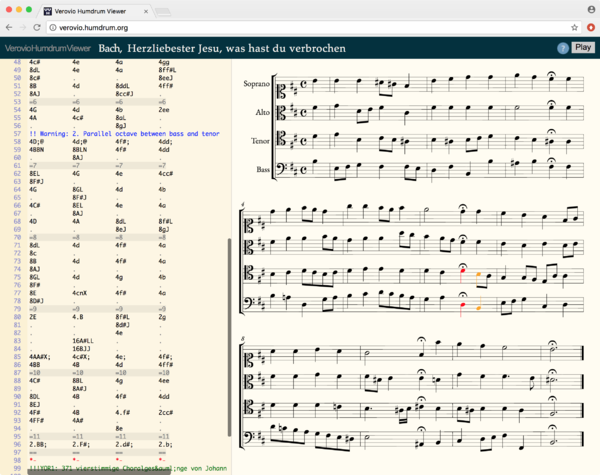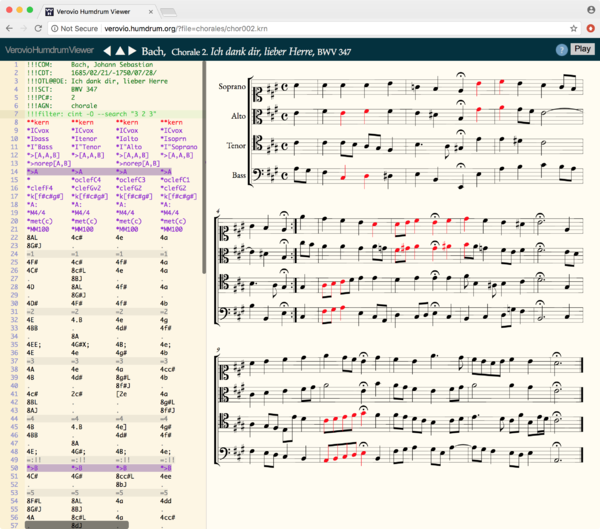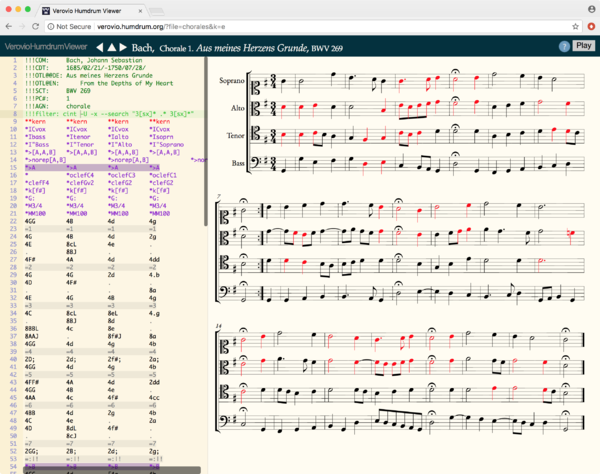Humdrum lab 8: Difference between revisions
| (5 intermediate revisions by the same user not shown) | |||
| Line 3: | Line 3: | ||
Update Humdrum extras by going to the humdrum-tools directory and typing: | Update Humdrum extras by going to the humdrum-tools directory and typing: | ||
cd $(which beat | sed 's/humdrum-tools.*/humdrum-tools/') | |||
make update | make update | ||
make | make | ||
| Line 181: | Line 181: | ||
The most common is a repeated 3rd. | The most common is a repeated 3rd. | ||
=== Note attacks/sustains === | |||
Renaissance music is more polyphonic than Bach chorales, so it is better to indicate if the notes are attacked or sustained at each point in the module: | Renaissance music is more polyphonic than Bach chorales, so it is better to indicate if the notes are attacked or sustained at each point in the module: | ||
| Line 198: | Line 200: | ||
With respect to note attacks/sustains, a falling parallel 3rd is the most common, followed by a rising parallel 3rd. | With respect to note attacks/sustains, a falling parallel 3rd is the most common, followed by a rising parallel 3rd. | ||
== Regular expressions == | == Regular expressions == | ||
| Line 238: | Line 239: | ||
[[File:parallel3rds.png|600px|center]] | [[File:parallel3rds.png|600px|center]] | ||
== Chained counterpoint modules == | |||
Sequences of modules can be extracted or searched for by using the -n option: | |||
cint --raw chor001.krn -O -n 2 | head -n 10 | |||
3 8 3 -3 6 | |||
5 8 5 -3 8 | |||
8 8 8 -3 3 | |||
3 1 3 2 3 | |||
6 1 6 2 5 | |||
4 1 4 2 3 | |||
3 -3 6 1 5 | |||
5 -3 8 2 6 | |||
8 -3 3 2 6 | |||
3 2 3 -2 4 | |||
The -h option will put an "h" label on harmonic intervals (making it easier to read chains): | |||
cint --raw chor001.krn -Oh -n 2 | head -n 10 | |||
3h 8 3h -3 6h | |||
5h 8 5h -3 8h | |||
8h 8 8h -3 3h | |||
3h 1 3h 2 3h | |||
6h 1 6h 2 5h | |||
4h 1 4h 2 3h | |||
3h -3 6h 1 5h | |||
5h -3 8h 2 6h | |||
8h -3 3h 2 6h | |||
3h 2 3h -2 4h | |||
Also the attack markers are only added to harmonic intervals, so -x will also make it easy to distinguish between harmonic and melodic intervals: | |||
cint --raw chor001.krn -Ox -n 2 | head -n 10 | |||
3xx 8 3xx -3 6xx | |||
5xx 8 5xx -3 8xx | |||
8xx 8 8xx -3 3xs | |||
3xx 1 3xx 2 3xx | |||
6xx 1 6xx 2 5xs | |||
4xx 1 4xx 2 3xs | |||
3xx -3 6xx 1 5sx | |||
5xx -3 8xx 2 6xx | |||
8xx -3 3xs 2 6xx | |||
3xx 2 3xx -2 4xs | |||
Given a harmonic interval of a 3rd between two notes (where both are attacking at the same time), what are the input and output voice motions for that interval? | |||
cint --raw *.krn -Ox -n 2 | grep " 3xx " | sortcount -p | head -n 10 | |||
4.12 3xx 2 3xx 2 3xx | |||
2.57 3xx -2 3xx -2 3xx | |||
1.16 3xx -2 3xx -2 4xs | |||
1 3xx -2 3xx 2 3xx | |||
0.86 3xx 2 3xx -2 3xx | |||
0.81 2xs -2 3xx -2 4xs | |||
0.79 3xx 2 3xx 2 8xx | |||
0.78 3xx 2 3xx -2 4xs | |||
0.76 3xx 2 3xx 2 2xs | |||
0.73 3xx 2 3xx 1 4sx | |||
The most common case is that the 3xx interval is in the middle of a sequence of parallel thirds rising by step. The second most common is parallel thirds falling by step, and then the third most common cases is a falling stepwise parallel third followed by the lower note continuing down stepwise while the upper note remains sustained. | |||
== Attack/sustain configurations for modules == | |||
Searching for cases where the module is "5 -2 6", but then segmenting into attack/sustain cases: | |||
cint -x *.krn --raw | egrep "^5[xs]+ -2 6[xs]+" | sortcount -p | |||
57.46 5xx -2 6xs | |||
17.06 5xs -2 6xs | |||
11.03 5xx -2 6xx | |||
9.23 5sx -2 6xs | |||
4.74 5xs -2 6xx | |||
0.49 5sx -2 6xx | |||
The most common case for the "5 -2 6" module is for the two notes to attack together, then the bottom note drops a step while the top voice remains sustained (happening 57% of the time). The second most common cases is that the top note is sustained from a previous sonority while the lower voice is moving stepwise downwards through a fifth and then a sixth with the upper note. The third most common case occurs when both note are attack on both harmonic intervals of the module. | |||
{{humdrum_labs}} | |||
Latest revision as of 01:17, 30 June 2018
Update
Update Humdrum extras by going to the humdrum-tools directory and typing:
cd $(which beat | sed 's/humdrum-tools.*/humdrum-tools/') make update make
chorck
Chorck is a Humdrum Extras tool for checking the part-writing syntax of chorales. documentation for the chork tool
Eight syntax rules are checked by the program, as defined in the music-theory textbook: . Tonal Harmony with an Introduction to Twentieth-Century Music by Stefan Kostka and Dorthy Payne:
- Parallel 5ths between two voices when moving to different pitch classes.
- Parallel Octaves between two voices when moving to different pitch classes.
- Contrary parallel 5ths -- when two voices move in parallel 5ths displaced by an octave. (such as an octave and a fifth going to a fifth)
- Unequal 5ths -- when the bass part and another voice move from dim 5ths to perfect 5ths or vice versa.
- Hidden 5ths -- when the soprano moves in similar motion with another voice and the soprano leaps to a perfect 5th with that voice.
- Hidden 8va -- when the soprano moves in similar motion with another voice and the soprano leaps to a perfect octave with that voice.
- Voice crossing -- when an inner voice goes above the soprano voice or below the bass voice.
- Open spacing -- when the interval between successive voices other than the bass exceeds an octave.
How many times does Bach violate the rules?
chorck chor*.krn -w | wc -l
List of the rule violations by type
chorck *.krn -w | sed 's/between.*//' | sortcount 647 7. Voice crossing 491 5. Hidden 5th 441 8. Open spacing 243 6. Hidden octave 93 4. Unequal 5th 61 3. Contrary parallel 5th 36 1. Parallel 5th 6 2. Parallel octave
List of the rule violations by voice pairs
chorck *.krn -w | sed 's/on line.*//' | sortcount 338 8. Open spacing between alto and tenor 329 7. Voice crossing between tenor and bass 202 5. Hidden 5th between soprano and alto 191 5. Hidden 5th between soprano and tenor 174 6. Hidden octave between soprano and tenor 156 7. Voice crossing between soprano and alto 103 8. Open spacing between soprano and alto 98 5. Hidden 5th between soprano and bass 84 7. Voice crossing between alto and bass 78 7. Voice crossing between soprano and tenor 46 6. Hidden octave between soprano and bass 37 4. Unequal 5th between bass and soprano 32 4. Unequal 5th between bass and alto 24 4. Unequal 5th between bass and tenor 23 6. Hidden octave between soprano and alto 19 3. Contrary parallel 5th between bass and alto 18 3. Contrary parallel 5th between tenor and soprano 14 1. Parallel 5th between tenor and soprano 12 1. Parallel 5th between tenor and alto 11 3. Contrary parallel 5th between bass and tenor 7 3. Contrary parallel 5th between bass and soprano 6 3. Contrary parallel 5th between tenor and alto 4 1. Parallel 5th between bass and soprano 3 1. Parallel 5th between bass and tenor 3 2. Parallel octave between bass and alto 2 2. Parallel octave between bass and tenor 2 1. Parallel 5th between bass and alto 1 2. Parallel octave between tenor and soprano 1 1. Parallel 5th between alto and soprano
Which files contain parallel octaves?
chorck -wfr 2 chor*.krn 2. Parallel octave between bass and tenor on line 57 (chor078.krn) 2. Parallel octave between bass and tenor on line 52 (chor114.krn) 2. Parallel octave between bass and alto on line 65 (chor164.krn) 2. Parallel octave between bass and alto on line 94 (chor226.krn) 2. Parallel octave between tenor and soprano on line 34 (chor270.krn) 2. Parallel octave between bass and alto on line 45 (chor334.krn)
Looking at the rule violations in VHV
chorck -r 2 chor078.krn | pbcopy
Then paste into VHV:

Is a parallel octave at a phrase boundary a rule violation?
cint
cint is a tool that extract counterpoint modules from polyphonic music. documentation for cint
It is a generalized tool related to chorck, which is a specialized tool.
Getting a list of counterpoint modules in a piece
cint --raw chor001.krn | head -n 10 10 8 3 12 8 5 15 8 8 3 1 3 6 1 6 4 1 4 3 -3 6 5 -3 8 8 -3 10 3 2 3
The most common modules in Bach chorales:
cint --raw *.krn | sortcount | head -n 10 3500 5 -2 6 3354 6 2 5 2867 3 -2 4 2838 4 -2 5 2735 6 -2 6 2579 5 1 6 2498 3 -2 3 2479 3 1 4 2436 3 2 3 2414 10 2 10
The -O option will collapse compound intervals such as "10 2 10" into "3 2 3" (10th is an octave plus a 3rd).
cint -O --raw *.krn | sortcount | head -n 10 5070 3 2 3 5033 6 2 5 4746 3 -2 4 4394 5 -2 6 4213 5 2 3 4088 3 -2 3 3943 2 -2 3 3833 4 -2 5 3346 3 1 4 3335 6 -2 6
The most common module in Bach chorales is a rising parallel 3rd "3 2 3"
parallel thirds
The three-interval counterpoint module for stepwise rising parallel thirds is "3 2 3". this can be done as a filter in VHV:
!!!filter: cint -O --search "3 2 3"
The -O option collapses intervals greater than an octave to less than an octave, such as 10th (an octave plus a 3rd) being transposed to 3rds.

Josquin modules
What about in Josquin's music:
cint -R -O --raw h://jrp/Jos | sortcount | head -n 10 23123 3 1 3 19880 6 1 5 19517 4 1 3 19515 3 -2 3 18545 3 2 3 16389 3 -2 4 15812 5 -2 6 15784 5 1 6 15772 5 1 5 15625 8 1 8
The most common is a repeated 3rd.
Note attacks/sustains
Renaissance music is more polyphonic than Bach chorales, so it is better to indicate if the notes are attacked or sustained at each point in the module:
oznin:chorales css$ cint -R -O -x --raw h://jrp/Jos | sortcount | head -n 10
13912 3xx -2 3xx 13343 3xx 2 3xx 8782 6sx -2 8xx 7779 4sx 1 3sx 7402 7xs 1 6sx 7374 3xx 1 4sx 7315 4xs 1 3sx 6932 3xx -2 4xs 6878 6sx 1 5sx 6537 6xx 1 5sx
With respect to note attacks/sustains, a falling parallel 3rd is the most common, followed by a rising parallel 3rd.
Regular expressions
All parallel thirds in a chorale:
cint --raw chor001.krn | grep "3 .* 3" | sortcount 10 3 -2 3 10 3 2 3 3 3 1 3 1 3 4 3 1 3 3 3
Remove repeated note cases:
cint -U --raw chor001.krn | grep "3 .* 3" | sortcount 10 3 2 3 10 3 -2 3 1 3 4 3 1 3 3 3
With note attack information
cint -U -x --raw chor001.krn | grep "3[sx]* .* 3[sx]*" | sortcount 7 3xx -2 3xx 7 3xx 2 3xx 3 3xs 2 3xx 2 3sx -2 3xx 1 3xx 3 3xx 1 3xs -2 3xx 1 3xx 4 3xx
Highlight modules which are parallel 3rds without repeats where both notes attack on the thirds:
!!!filter: cint -U -x --search "3[sx]* .* 3[sx]*"

Chained counterpoint modules
Sequences of modules can be extracted or searched for by using the -n option:
cint --raw chor001.krn -O -n 2 | head -n 10 3 8 3 -3 6 5 8 5 -3 8 8 8 8 -3 3 3 1 3 2 3 6 1 6 2 5 4 1 4 2 3 3 -3 6 1 5 5 -3 8 2 6 8 -3 3 2 6 3 2 3 -2 4
The -h option will put an "h" label on harmonic intervals (making it easier to read chains):
cint --raw chor001.krn -Oh -n 2 | head -n 10 3h 8 3h -3 6h 5h 8 5h -3 8h 8h 8 8h -3 3h 3h 1 3h 2 3h 6h 1 6h 2 5h 4h 1 4h 2 3h 3h -3 6h 1 5h 5h -3 8h 2 6h 8h -3 3h 2 6h 3h 2 3h -2 4h
Also the attack markers are only added to harmonic intervals, so -x will also make it easy to distinguish between harmonic and melodic intervals:
cint --raw chor001.krn -Ox -n 2 | head -n 10 3xx 8 3xx -3 6xx 5xx 8 5xx -3 8xx 8xx 8 8xx -3 3xs 3xx 1 3xx 2 3xx 6xx 1 6xx 2 5xs 4xx 1 4xx 2 3xs 3xx -3 6xx 1 5sx 5xx -3 8xx 2 6xx 8xx -3 3xs 2 6xx 3xx 2 3xx -2 4xs
Given a harmonic interval of a 3rd between two notes (where both are attacking at the same time), what are the input and output voice motions for that interval?
cint --raw *.krn -Ox -n 2 | grep " 3xx " | sortcount -p | head -n 10 4.12 3xx 2 3xx 2 3xx 2.57 3xx -2 3xx -2 3xx 1.16 3xx -2 3xx -2 4xs 1 3xx -2 3xx 2 3xx 0.86 3xx 2 3xx -2 3xx 0.81 2xs -2 3xx -2 4xs 0.79 3xx 2 3xx 2 8xx 0.78 3xx 2 3xx -2 4xs 0.76 3xx 2 3xx 2 2xs 0.73 3xx 2 3xx 1 4sx
The most common case is that the 3xx interval is in the middle of a sequence of parallel thirds rising by step. The second most common is parallel thirds falling by step, and then the third most common cases is a falling stepwise parallel third followed by the lower note continuing down stepwise while the upper note remains sustained.
Attack/sustain configurations for modules
Searching for cases where the module is "5 -2 6", but then segmenting into attack/sustain cases:
cint -x *.krn --raw | egrep "^5[xs]+ -2 6[xs]+" | sortcount -p 57.46 5xx -2 6xs 17.06 5xs -2 6xs 11.03 5xx -2 6xx 9.23 5sx -2 6xs 4.74 5xs -2 6xx 0.49 5sx -2 6xx
The most common case for the "5 -2 6" module is for the two notes to attack together, then the bottom note drops a step while the top voice remains sustained (happening 57% of the time). The second most common cases is that the top note is sustained from a previous sonority while the lower voice is moving stepwise downwards through a fifth and then a sixth with the upper note. The third most common case occurs when both note are attack on both harmonic intervals of the module.
| Lab 1 (intro) | Lab 2 (Essen) | Lab 3 (searching) | Lab 4 (JRP) | Lab 5 (Wikifonia) | Lab 6 (bar chart) | Lab 7 (regular expressions) | Lab 8 (chorck & cint) |